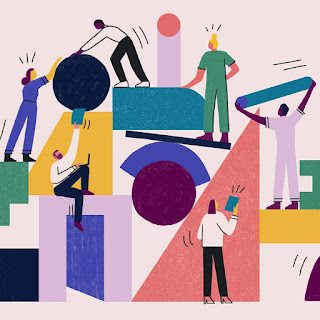‘A Creative Leader’
*This article is a repost from my previous blog ABC (Art, Business, Creativity), which is due to technical reasons is no longer on operation. How important is it for a Leader to focus on the development of his/her creative elements?
How do creativity and leadership connect to each other? How should a Leader manage himself and his team to achieve businesses goals?
Creativity is characterized by the skill and the power of using the imaginative ability to produce something new, fresh, such as as services, as and products as in a new form and is above all the source of innovation.
Creativity, according to the most important business organizations, will be in the future the most important skill – characteristic of entrepreneurship and of our everyday life.
Recently Adobe published a global research about creativity in the workplace, in the education system and our society.
A research based on interviews of around 5.000 people, from USA, UK, Germany, France and Japan research shows that 8 in out of 10 people aim believe that unblocking creativity is essential for economic growth but only a few people (only 1 out of in 4), could express and live their own potential.
According also to very significant organizations, Creativity is the most important skill in business for the future…
An example at the link below.Especially for a Leader focusing on creativity is a very important skill especially when he/she collaborates, communicates, develops the company’s / organization’s vision, solves complex problems, negotiates or even when he/she comes in touch and connects with his/her associates, employees, customers and competitors.
Creativity is essential for maintaining the balance between IQ and EQ. Creative leaders work with his/her instinct, focus and embrace, are imaginative, accept criticism, seek progress, balance themselves and their team, motivate people and are not afraid to operate out of the box.
In addition, they are visionaries, their work is purposeful and they always act as artists do.
‘A Creative and Innovative Leader must be open minded and good learner, to be receptive and to collect by different sources and different people. To knead and work his/her mind through critical thinking. Must be visionaire and when is needed to function beyond traditional ways’.
What are the main features that distinguish creative leaders?
Creative leaders:· Explore - express and try new trends in society, whether it is technology, art, even new products, services, etc.
· They steal an idea, as the artist does, recreating and repositioning, presenting it through his/her own vision.
· They operate through critical thinking, because their mind is always in a creative process.
· They connect and bridge the present with the past and the future, the old with the new, and they are curious about what is surrounding them by seeking the unexplored, as artists do.
· They try to transform others by setting an example.
· Create space for shared experiences.
· They can change our lives virtually, having the ability to come up with ideas to solve problems and exploit opportunities.
· Convert creative ideas into new products and services.
· They have imagination, curiosity, authenticity and are reformers.
· Approach and attract the right people, at the right times, to the right level for the implementation of the project.
· They allow their team to be more creative and they set the right example for their group.
· They constantly ask questions, have their own identity and are not afraid to argue with the traditional thinking.
· Accept the inevitable and the value of failure, create psychological security to maximize learning from failure, recognize the different levels of failure and how it can be useful, and the value of the second chance.
Creative Leaders engagement:
Asks inspiring questions, allowing ideas to bubble up from the workforce, helps others succeed, use metaphors, analogies, and stories—to help teams conceptualize together and get people with different backgrounds and expertise to work together.
Encourage individuals to gain diverse experiences that will increase their creativity and provide sufficient time and resources for exploration.
Accept the inevitability and utility of failure, create psychological safety to maximize learning from failure, recognize the different kinds of failure and how they can be useful and create good mechanisms for filtering ideas without killing dead-end projects.
Motivate others with intellectual challenge, clear paths through the bureaucracy for creative ideas, allow people to do ‘good work’, show the higher purpose of projects whenever possible.
Creative Leaders should always ask questions to themselves, in order to continuously progress. Some example questions are:
Creative Leaders have gut instinct, focus and embrace, are imaginative, accept criticism, seeking for progress, balance themselves and their team, motivate people/employees, aren’t afraid to expose their thoughts, being outside of the box, being authentic.
‘Imagination, Curiosity, Intent, Focus, Engagement, Authenticity, Criticism, Form and Reform, Skill, Representation, Context and Purpose are elements of a creative Leader’.
In today's growing competition and emerging need to study continuous social changes, we require creative leaders in entrepreneurship, visionaries, flexible leaders to inspire and who do not hesitate to take risks. Creative leaders who are motivated by their passion such as Henry Ford, Steve Jobs, Oprah Winfrey, Richard Branson, constantly seeking new ideas, innovation, connecting the seemingly unconnected, which is the basis of creativity and innovation.
A Creative Remarkable Leader he/she builds great teams around him/her that are diverse, innovative and courageous, to help him/her succeed every day…
‘Creativity at its highest point is to connect the IQ with EQ and both to work in balance.’
* The Adobe’s study was produced by research firm StrategyOne and conducted as an online survey among a total of 5,000 adults, 18 years or older, 1,000 each in the United States, United Kingdom, Germany, France and Japan. Interviewing took place from March 30 to April 9 2019. The data set for each country is nationally representative of the population of that country.







